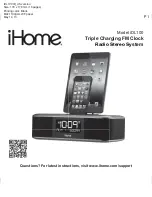
hour until a signal is received. If the time is manually set the clock will continue to periodically search for a signal
and automatically reset the hands when the signal is received.
Select a location to place your radio controlled clock where it will be at least six feet away from a TV,
computer, air conditioner or other household electrical appliances. The optimal location is near a window.
Windows facing Colorado providing the best signal. The WWVB time signal will easily penetrate Masonry and
wood framed buildings. WWVB will penetrate almost every residential building and most steel buildings if they
have adequate windows. It is not possible, however, for WWVB to penetrate most indoor shopping malls and
rooms in the center of large office buildings that do not have windows. In buildings that WWVB cannot penetrate
you may set the time using the manual time set button. When the clock is exposed to the WWVB signal it will
automatically set the hands to the exact time.
La Crosse Technology clocks do not receive or process radio controlled time signals from Germany’s DCF
77, Japan’s J Ga AS, or England’s MSFs atomically regulated transmitters. La Crosse Technology clocks can be
manually set and used anywhere.
For more information on the NIST and radio controlled time, see www.boulder.nist.gov/timefreq/
Troubleshooting
The wonderful advantage of owning a La Crosse Technology radio controlled clock is that it is virtually trouble
free. If the clock receives a clear signal it will set itself perfectly. If it does not receive a signal consider the
following:
Battery -
The La Crosse Technology clock must have a fresh battery to receive and process the time signal.
Location -
Try a different location, ideally near a window. It should be at least six feet from computers, TVs, air
conditioners, other Radio-Controlled clocks and other electrical appliances that cause interference.
Weather -
Electrical storms between you and Colorado during the night will interfere with the WWVB signal.
Although we cannot control the weather we can help you predict it (see www.lacrossetechnology.com).
Daylight Savings Time
The National Institute of Standards and Technology and WWVB encode a special DST “bit” in the WWVB
transmission for DST. Your La Crosse Technology clock will read this information and automatically advance the
hands one hour in the spring and eleven hours in the fall.
Arizona and Indiana
If you live in an area that does not recognize DST you must press the (unmarked) DST button for one second to
deactivate your clock’s DST program. To reactivate the DST program simply press the DST button again for one
second.
Frequently Asked Questions
Q. How long will the battery last?
A. A good AA alkaline battery will last over one year. If your clock is located in an area with little interference
where it can quickly receive a signal the battery can last much longer than one year.
Q. Can a La Crosse Technology clock be used outdoors?
A. Yes, but only in a dry environment and in a temperature range between 41 F and 131 F. The clock is NOT
water-resistant.
Q. Can the La Crosse Technology clock be wired to control timing circuits?
A. No.
Q. Why does the second hand move only once every two seconds?
A. When the battery drops below 1.25 volts the clock indicates that it is time to change the battery by advancing
the second hand in two second steps. The operating voltage range is 1.25 to 1.75 volts.





















